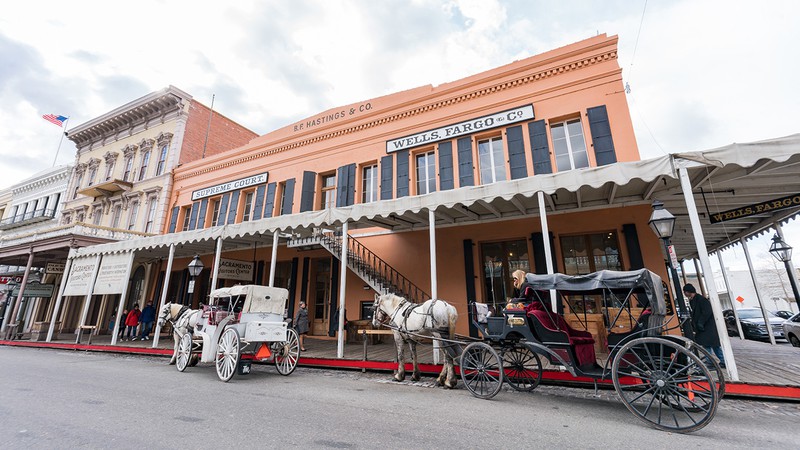
Old Sacramento Historic District Sacramento is an open-air museum of historic buildings. Kit Leong Shutterstock.com
An exasperated Charles de Gaulle once declared France to be fundamentally ungovernable. California probably is, too. In Sacramento—the county and city that surround the Capitol—they do their best.
Sacramento has been the capital of California since 1854, when it was a flood-prone and pestilential outpost. It was first a jumping-off point for the gold miners of ’49. It was later the headquarters for the railroad barons, who fixed the agricultural prices throughout the state for decades. They didn’t call the Southern Pacific railroad “The Octopus” in honor of its intelligence and mysteriousness. This fundamentally underrated city has always been politically fractious. It’s said that in the 1880s, the Democratic and Republican HQ buildings were so close that the partisans could throw rotten eggs at each other. So they did.
We know from Joan Didion what sort of place Sacramento was, once—full of a sense of destiny, a pride in the fertility of the farmland and the grandeur of its buildings. Many of the edifices are still there, as ostentatious as ever. The banker and railroad builder Charles Crocker had a brother who was a judge; his mansion became the Crocker Art Museum. Founded in 1885, it’s the oldest art museum west of the Mississippi. It has a collection of first-rate tribal pieces from New Guinea, and a special interest in the vivid and playful 1970s “funk art” of the region. William T. Wiley, Robert Arneson and Wayne Thiebaud studied and taught nearby. As a history lesson, the museum has preserved a salon-style exhibition of what an art show in a cultural frontier looked like, back in the Gilded Age of the late 1800s: religious allegories, stiffly posed portraits, and highly speculative artists’ conception of lions and grizzly bears.
Swiss immigrant John Augustus Sutter (1803-1880) fled his debts, his wife and his five kids, and went west. After a series of journeys, he came to Monterey and petitioned Governor Alvarado for land; Alvarado, fearing the schemes of rival European powers to invade Alta California, granted Sutter 4,800 acres in Sacramento. Sutter titled his settlement ‘New Helvetia’ in honor of Switzerland. To build it, he was enterprising enough to buy, as salvage, the abandoned Russian settlement of Fort Ross on the foggy Sonoma coast. Sutter shipped materials more than a hundred miles. Supposedly among the lot were guns the tsar’s troops had captured from Napoleon’s army, as well as a large cargo of horses, cattle, and 9,000 sheep. Sutter surrounded his fort with 18-foot walls, but this would-be colonist lost it all when the Gold Rush came in. Sutter ended his days in Lititz, Pennsylvania, vainly suing the U.S. government to get his land back; his reconstructed fort contains historical items from the settlement.
No word but “genocide” describes what befell the vast and varied original population of this state, with their different cultures and tongues and strategies for living life here. And few have reckoned with this bloodshed. Opened right before WWII, this collection includes artifacts, regalia and—this is something the Northern California natives particularly excelled at—stunningly deft basketware. Some pieces are so small you need a magnifying glass to study them. The museum gives a sense of how the original inhabitants of the state once lived, and plans are under way for an expansion.
The Sacramento Historical Society, founded in 1941, examines Sacramento’s key roles in the creation of California, in the Pony Express, and the Union Pacific railway which connected coast to coast.
This museum, dedicated to the history of the state, was temporarily closed because of the COVID-19 pandemic, but it reopened in May of 2021—and is well worth seeing. The California Hall of Fame is on its grounds, as are many artifacts of the history of the California Republic, from the pioneer days to the triumphs of the cinema industry, aerospace, and electronics.
Sacramento’s Old Town is an open-air museum of several square blocks of historic brick buildings, plus hot dogs, bottomless mimosas, gross T-shirt stands, horse-drawn carriages, and a riverside boardwalk. A cornerstone to Old Town, the Sacramento History Museum explains the roots of the city—roots that are literally exposed in the Old Sacramento underground tour this organization offers, showing the foundations of the old city before it was rebuilt to rise above the constant floods.
Sacramento’s days as a nationally important railroad hub are commemorated in this excellent museum. Its collection includes 19 steam locomotives—one dates back to the Civil War. Exhibits have explored the history of the Chinese laborers who helped excavate the Union Pacific’s way through the Rockies and the Sierra, and how the refrigerated car changed the history of West Coast farming. On certain days, excursion trains take visitors on a steam-powered ride along the banks of the Sacramento.